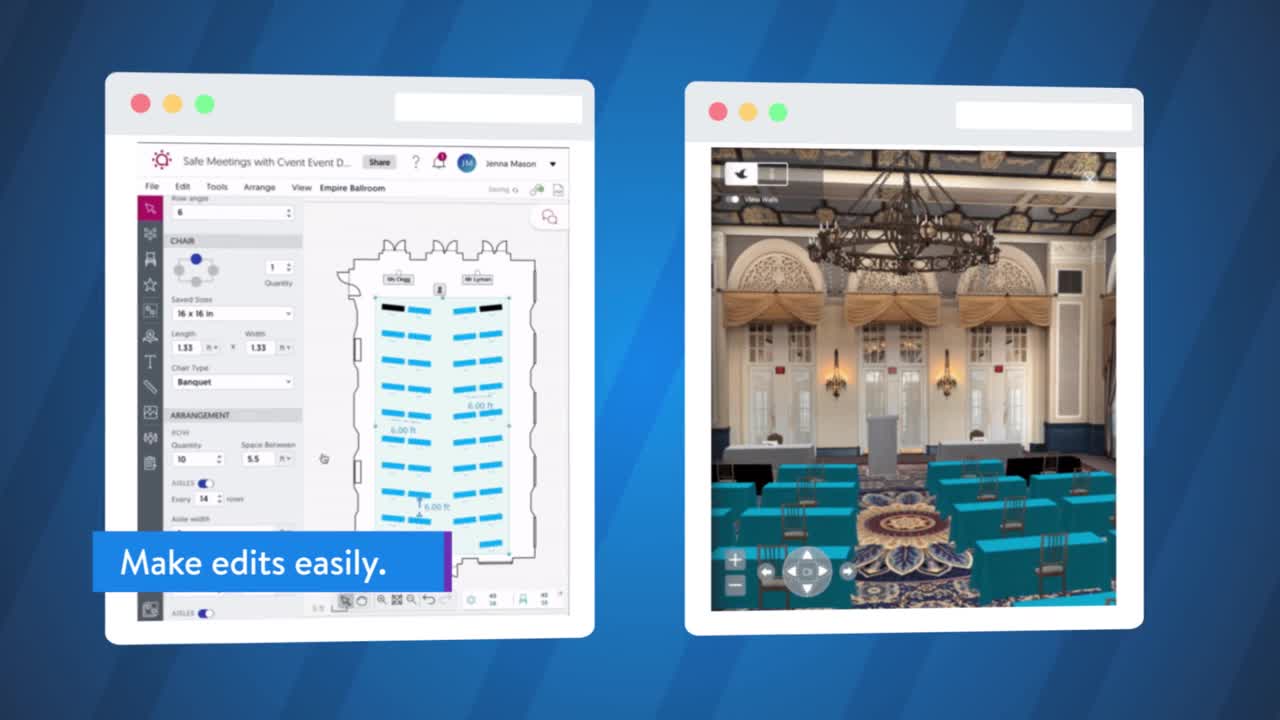COVID-19 has undoubtedly changed the way we work, travel, and live. But it has also transformed the way we meet. Attendance is capped, room setups are more spread out to accommodate social distancing, and F&B options are different and limited. Hybrid events are also taking center stage, with a smaller number of in-person attendees and a virtual component broadcasted to a virtual audience. This shift, which features the prominent use of technology solutions like room diagramming, is a trend that is here to stay.
In this blog post, we go into greater detail on room diagramming and interactive floor plans. We explore how these tools can create safer meetings, as well as how hotels can use technology to conduct safer site tours. We hear from Gino Marasco, Director of Sales and Marketing at Wyndham Orlando, and we also interview Caitlin Nicolson of Cvent Event Diagramming to get her perspective on how hotels can revamp their sales and adapt to the new environment of meetings and events.
Explore how room diagramming and interactive floor plans contribute to safer meetings and events
Smaller meetings, some of 25 people or less, are now taking place in ballrooms designed to fit 300 people – all in order to meet safer meeting requirements. This is the reality of in-person meetings until a time when it’s safe to gather. However, it's possible to create a socially distant and safer meeting while still prioritizing the event experience. Room diagramming and interactive floor plans, which are becoming increasingly critical tools for hotels, are a good way to communicate these aspects to planners.
Get started with room diagramming today!
Today’s digital and careful world requires transparency, and showing your meeting space on marketing channels, during sales, and in communication with groups is the type of clarity that planners require. Providing examples of safer floor plans and diagrams is now a crucial part of the total process.
Ultimately, the question on every planner’s mind is this: What does the experience look and feel like from the attendee point of view? Think about the attendee journey from the time they arrive at the hotel. Is their meeting room at the end of a long hallway with five other meeting rooms that may be in use to pass on the way? Are they in a private area of the hotel with no other meeting rooms? Where are the bathrooms? Think beyond the meeting space and anticipate the entire meeting experience.
In addition to providing clear diagrams, it can be helpful to zoom out and show all the meeting rooms within the area. This will eliminate the chance of any surprises and give the planner a bird’s eye view of the attendees’ journey through the event space. The ability to showcase the experience in an interactive, digital way, gives confidence to planners both in terms of safety and success.
But of course, room diagramming and interactive floor plans go much deeper than simply showcasing the event space and its surrounding areas.
The changing nature of site visits
With social distancing requirements and restrictions on the number of attendees, suppliers need to pivot and become experts on how planners can host a successful, engaging, and safer meeting in their space. It’s the hotel’s job to figure out what events will look like at their venue. But how can suppliers show the space to potential planners who may not have the opportunity to visit in person? Four Seasons Hotel Toronto, for example, found a solution.
Because of the pandemic, couples and planners weren’t coming into the hotel as often as they used to. Four Seasons realized they needed realistic photos of the space, preferably with their clients’ desired set-up. But what are hotels to do when they aren’t “virtual” experts?
Four Seasons Toronto recognized early on that they would need assistance, and leveraged partnerships with Cvent and PSAV, an A/V company. Instead of walking through an empty ballroom with an iPhone, they needed a seamless, higher-quality, method, and created a virtual site tour to show the flow, personality, and uniqueness of the space.
This photo-realistic and immersive experience gives planners the comfort of knowing that safety is a top concern and that the hotel does not compromise on quality. Virtual tours and more engaging remote preview methods allow suppliers to collaborate effectively with clients – all while saving time and maintaining a safe distance.
Hotel Nia has also utilized Cvent Event Diagramming to be more efficient in their sales processes. Julie Ramey, Director of Sales and Marketing at Hotel Nia, said the convenience of the tool and how it can be used to substitute in-person site visits is what helps to streamline their processes.
“When you look at working smarter and not harder, (Cvent Event Diagramming) has really been the key to our success,” says Ramey. “Because we’ve been able to redirect client visits to the tool, we’re able to cut down on face-to-face appointments, while still providing an elevated service experience. Effectively, it’s like having another assistant in the office, for us to be able to use (Cvent Event Diagramming) on a day to day basis.
“We can send a link to our client and get on a conference call and have real-time diagramming with 3D imaging of the room, so they can see how great it’s going to look, without necessarily spending the extra two hours for a site visit.”
Even when it’s safe to travel again, some event professionals might prefer to continue conducting site visits virtually in order to save on time and costs. And with the busy life of an event professional, time is something that’s always in short supply.
Cvent Event Diagramming success story: Wyndham Orlando
Gino Marasco, Director of Sales and Marketing at Wyndham Orlando, describes a promising lead the property received in January 2020 for an event taking place in December 2020. Everything was moving forward as expected – until the pandemic hit, and group business came to a standstill. Wyndham Orlando’s sales team still communicated with the planner and learned they were concerned about social distancing, and if hosting the event in-person would even be possible.
“So, reading between the lines, we said, ‘What can we do to combat this?’” said Marasco. “We worked with (Cvent Event Diagramming) and we created diagrams with social distancing in mind, both the general session and the breakouts, with six-foot spacing in between for their meetings and their meal periods.
Learn all about the latest group business best practices
“We reached back out to the customer, sent them the diagrams, and they were blown away that we could create something with social distancing in mind that was accurate. It really was the deciding factor in them having the confidence that they could host their program with us, and we received a signed contract.”
When they asked the client what ultimately earned them the business, the planner said it was the fact Wyndham Orlando preemptively created the socially distant diagrams without them having to request it.
Anticipating planner needs and coming to the table with a solution ready can go a long way in showcasing your venue’s expertise and preparedness to host a safer meeting.
How hotels can use room diagramming and other tools to set themselves up for success
We chatted with Caitlin Nicolson of Cvent Event Diagramming to get her take on the changing meetings and events environment, and how hotels can set themselves up for success once group business gets back on track.
Q: What does “safer meetings” mean to planners, and how have their expectations of venues changed since COVID-19?
A: This is definitely a question hotel sales and event managers should be asking planners – “What does a safe meeting mean to you?” For example, to some planners, a “safe meeting” will be maintaining six feet between all guests. And for others, it’s having extra hand sanitizer stations at every table (while also following all recommended local, state, and federal guidelines). Sometimes a planner’s request can be more stringent than what your hotel’s protocols cover. Uncovering the planner’s definition will help set the stage for creating the perfect “safer meeting” at your property for that client.
Now more than ever, planners are really looking to and relying on hoteliers for answers. Sharing with planners what other setups groups are contracting will not only give them options, but show that your hotel is ready for business. The ultimate goal is to give planners confidence in your property and a level of comfort to the attendees to win the business.
Q: What are some tips and strategies for how hotels can boost group business and revamp sales as they work through the pandemic?
A: Using diagrams to complement the sale will go a long way with planners. Anticipate their needs by showing them several options for a safer meeting in your space. This will demonstrate a vested interest in the business and give planners the level of comfort they’re looking for.
Use technology to graphically show the clients the flow and pathing of their event and others around them. Give planners the ability to experience your property while they are at home through a virtual site tour.
Think beyond the four walls of your meeting space – attendee numbers are smaller right now, so get creative! Think about using a presidential suite for a board meeting or a restaurant terrace for a wedding reception.
Put your best marketing foot forward. Leverage distribution channels with the content planners need to see. Having better meeting space collateral on your marketing channels helps you stand out among the competition. If you’re not sure where to start, updating your profile on the Cvent Supplier Network is a great place to begin.
Put this information on the importance of room diagramming to good use!
Looking for more about safer meetings technology? Check out our guide to safe meetings and events.








